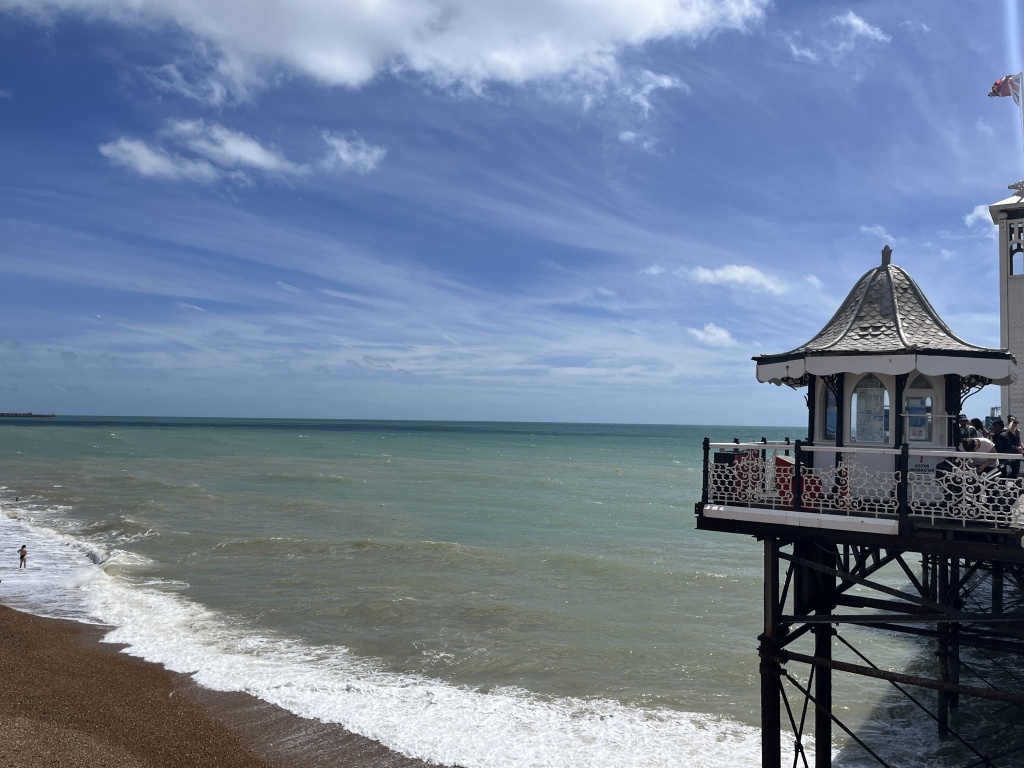Rest; Modernization and Preservation
Yr. correspondent and his associate did in Brighton exactly as they set out: to press pause. I relaxed my attentive anthropological eye, as well as my tendency to exhaust the day with as many outings as possible. And Brighton was brilliant for these restorative ends: even when overcast—as it was, fortunately, only once during our stay—its quaint niches (galleries, dive bars, &c.), friendly residents, and seaside attractions shone through.
In the afternoons, we bounced between the pebble beach and pier—where, despite my utmost efforts, I was unable to best any carnival games. Often, as consolation, I would indulge in a 99 flake; it proved a fitting, albeit sweet, aperitif for the tour’s finest fish and chips. Thus we left Brighton well-fed and -rested, keen to maximize our time on the continent.

I imagined this post would finish after these brief remarks, but my partner suggested an intriguing bridge between the themes of Brighton and Brussels. For, she detailed, the question behind modernization and, more so, preservation is which places, institutions, and communities are allowed to rest unperturbed. Her creative double-meaning became a useful lens via which I considered much of the municipal history of Belgium’s capital.
Urban development is central to the identity of the Bruxelloise; it shapes their lives from their daily commute up to the collections in their city museum (the top floor of which is devoted entirely to the topic). Our principal source of diversion, as it is for many tourists, was the Grand-Place; therein, we sampled many of the country’s culinary staples: mussels, frites, waffles, chocolate—and, of course, beer. The Place began as a classic medieval market (the Dutch call it ‘Grote Markt,’ accordingly), and, throughout the early modern period, it swelled in commercial importance, hosting guildhalls distinguished by their (oft-gilt) 17th c. facades. It suffered near-total destruction during the Nine Years’ War and successive devastation at the hands of the French revolutionary sans-culottes. Notably, until the late 19th c., most re-building demonstrated reckless disregard for the square’s historical significance.


And such a lack of restraint was not unique to the Place; ‘Brusselization’ (at large) is synonymous in urban planning with hastily-executed construction. In fact, ‘Brusselizing’ effects seem to be more clearly felt outside of the medieval city center. The 15th c. Church of Our Blessed Lady of the Sablon, in the upper town, is now surrounded by luxury shops, designed to attract the savvy contemporary consumer. Likewise, the European Quarter—Brussels acting as the seat of the EU Parliament—is strikingly postmodern; it stands in sharp contrast to the 19th c. Royal Quarter, only a kilometer away, with its more historically-authentic combination of an expansive park, a palace, museums, monuments, and native governmental offices.



Similar to the Royal Quarter, the Place feels honest to its past, though the Town Hall and King’s House are all that is left standing from its inception. Why might this be? I am sure these structures, as well as the aforementioned facades, help. But I think there is a deeper cause, too: namely, a push by the city to respect the space’s tradition and, thereby, to pedestrianize the area. In yr. correspondent’s estimation, it was the pockets of historic and architectural import, when afforded rest and used as they once were, that sparked my most sincere appreciation. With no cars to fear, my associate and I ambled around the Place, staring up in awe constantly and, when we eventually reached the Manneken Pis (a juvenile instance of the Belgians’ good humor), laughing wildly.

G.K. Chesterton, a more staunch traditionalist than I, labeled democracy an “arrogant oligarchy of those who merely happen to be walking about.” While I find this maxim’s political application dubious, it can be fairly said that municipal development is ruled by a tyranny of the living. Yet it should not be subjected thus: Brussels is a lesson in the consequences of when our construction is shackled to present interests and inputs, not to mention the triumphs of when it is not.
Bree’s ‘Fun Corner’:
Brighton: As a person who enjoys geology, seeing a pebble beach for the first time was so exciting. This, paired with the pier, the views, and the food made Brighton such a special place for us to take a rest before heading to the continent. Dog viewing: 7/10, lots of dogs to see along the beach, but many of the green spaces around were not dog-friendly (boo!). (Best spots: Brighton Palace Pier, Captain’s, anywhere you can get a 99 Flake!)
Brussels: Brussels was a beautiful city that took great pride in preserving history by keeping any new construction well away from the Grand-Place. No matter where you were in the city, there was always a new building, plaza, park, or entertainer to marvel at. All of the sights, sounds, people, and eats around Brussels made it clear why it was chosen to be the capital of the EU. Dog viewing: 5/10, since it is such a touristic location, not many dogs were present outside of parks. (Best spots: Ballekes, Brussels City Museum, Sisters Café, Pierre Marcolini chocolates)